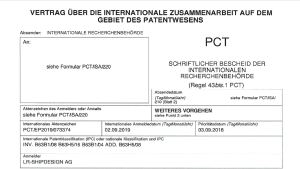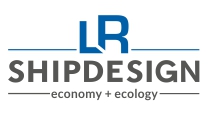The technology
The patent

In a few sentences we describe how our technology works.
By modifying the rear hull, an improvement in hydrodynamics is achieved. The advantages of the water flow towards the propeller are caused by a hydro-mechanical effect that creates further synergies.
- Due to the special shape of the semi-circular form at the bottom of the ship, the applied pressure is directed and accelerated by the indentation. This reduces energy losses and optimises the flow pattern at the side lines (rear shoulder) and stern.
- Due to this precisely calculated system, the flow of water towards the propeller and rudder is much better. The propeller has more pressure, especially in the 12 o’clock position, and can generate more thrust overall at less RPM of the main engine.
- The new propeller and rudder setup also allows the rudder to be more efficient in improving the wake flow. This holistic innovative approach delivers the optimum in technological improvements to already optimised designs.
The Impact
Advantages of the Patented Hull Lindinger are:
- Fuel reduction of up to approx. 10% in regular operation
- No direct investment costs for the ship owner
- Favourable licence fee with short period of payment, financed with the fuel savings
- No additional maintenance costs during operation
- No restrictions in cargo volume and at the same time better ship performance while in service
- Improved efficiency of the propeller due to reduction of suction coefficient and reduction of slip
- More favourable propulsion technology possible
- Compliance with all new environmental regulations due to EEDI
- Reduced vibration and noise of the main engine
- Active cost reduction due to synergy effects
- Functional for all semi-glider and displacement hulls
These advantages can be implemented with all propulsion systems and are suitable for all common ship types. This also applies to inland and cruise vessels (as well as to navy vessels).
Performance improvements are achieved across all speed and draught parameter variations without being exposed to the negative characteristics of ESD.
The results
Test runs at the Vienna Ship Model Basin (VMB)
Results with stock propeller for low speed container feeder vessel.
Projekt BC 76k, “Owner’s best design 2021” – LR-Shipdesign AG- Tanktest summary
Panmax class
| Sequence | 6 | 7 | 9 |
| list and result HSVA Hamburg | |||
| Date | 20.10.2021 | 21.12.2021 | 24.06.2022 |
| Task Type | Tanktest | Tanktest | Tanktest |
| Host | HSVA | HSVA | HSVA |
| Hull lines | Best design Owner | LR-V 11.5 | LR V 11.5+ |
| Propeller | D=7 m Owner | D=7 m | D=7 m Design LR |
| Ruder | Best design | Best design | Design LR |
| Resistance 13 kn | 3862 kW | 3745 kW | 3709 kW |
| Propeller Efficiency 13 kn | 0,706 | 0,703 | 0,726 |
| ETAD | |||
| rpm | 83,3 | 80,1 | 80,9 (80,2) |
| Delivered Power 13 kn /kW | 5468 kW | 5331 kW | 5106 kW |
| Remarks | Test values of the original best design determined in the HSVA as a benchmark | Evaluation of propeller geometry to increase efficieny-hull/propulsion. Beginn rudder/propeller optimization | Test drive with maximum optimization through AFT OPT®, evaluation of further improvements |
| Main engine room customized with coordination Owner/MAN (like V 11.2) | |||











